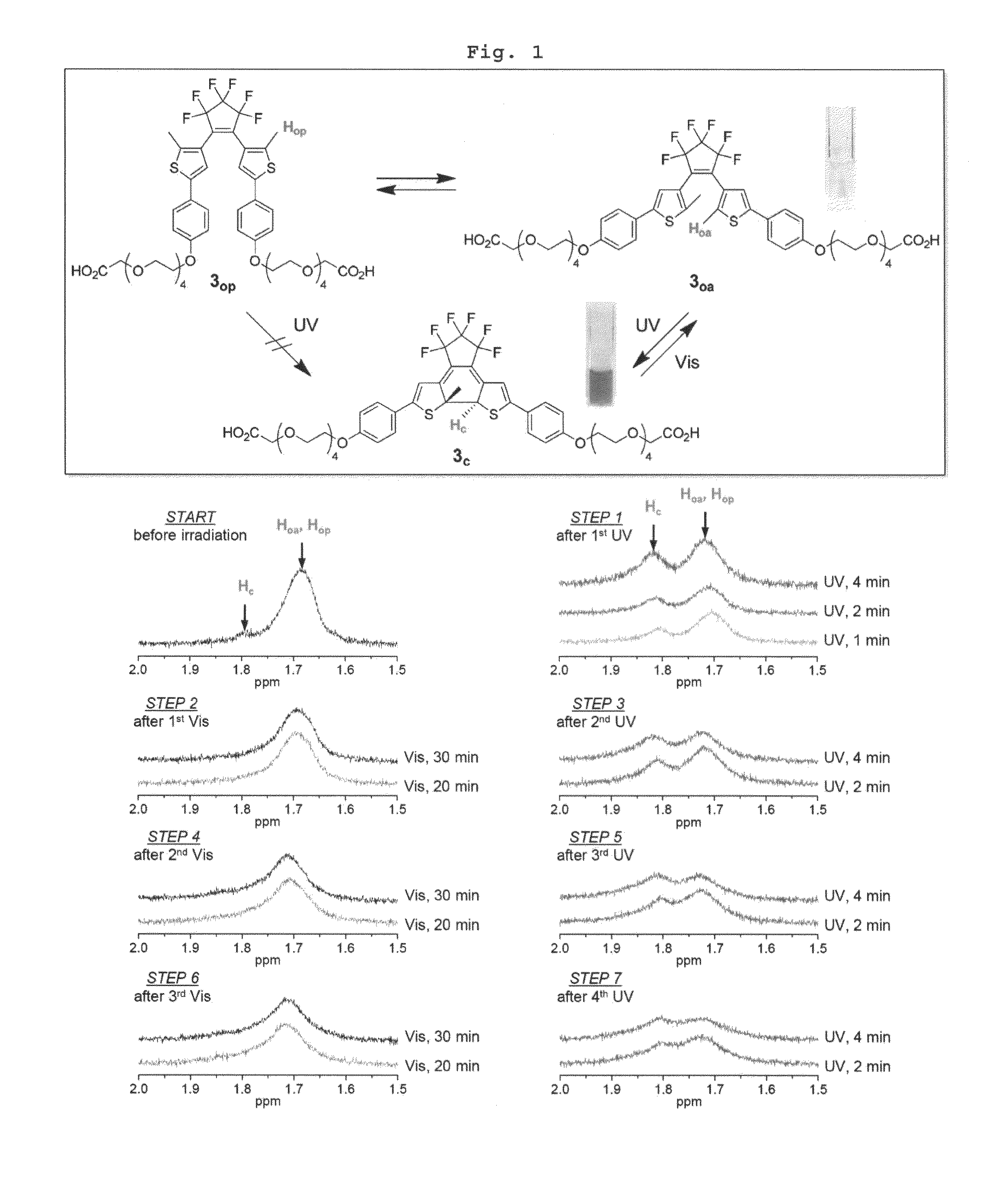Reversible Fluorescence Photoswitch based on Dye-Crosslinked Dendritic Nanoclusters for High-Contrast Imaging of Living Biological Systems
a dendritic nanocluster and fluorescence photosynthesis technology, applied in nanotechnology, organic dyes, nanosensors, etc., can solve the problems of limited biological application use of diarylethene derivatives and inappropriate use of molecules
- Summary
- Abstract
- Description
- Claims
- Application Information
AI Technical Summary
Benefits of technology
Problems solved by technology
Method used
Image
Examples
preparational example 1
Preparation of Photochromic Diarylethene 3
[0080]Step 1: Preparation of Intermediate compound 11
[0081]To a solution of diarylethene diphenol represented by Chemical Formula 9 (500 mg, 0.905 mmol) and the linker represented by Chemical Formula 10 (761 mg, 1.81 mmol) in N,N-dimethylformamide (DMF) (40 mL) was added oven-dried potassium carbonate (K2CO3) (376 mg, 2.72 mmol). The reaction mixture was stirred at 90° C. for 10 h, cooled to room temperature, and concentrated under reduced pressure. The residue was dissolved in methylene chloride (CH2Cl2; 100 mL), washed with water (50 mL×3), and the organic layer was dried over MgSO4. After removal of the solvent under reduced pressure, the crude product was chromatographed on silica gel (ethyl acetate (EtOAc)) to give 750 mg of the target compound as represented by Chemical Formula 11 (0.715 mmol, 79%).
[0082]Rf: 0.60 [silica gel, 15:1 CH2Cl2 / methanol (MeOH)];
[0083]1H NMR (500 MHz, DMSO-d6; ring-open isomer) δ 7.54 (d, 4H, J=8.6 Hz, H3o), 7...
example 1
Preparation of Dendritic Nanocluster 1a
[0091]Step 1: Preparation of Dendritic Nanocluster 4
[0092]A 90.76 mM solution of compound 3 prepared in Preparational Example 1 in DMSO-d6 (120.0 μL, 10.89 μmol) was added to the dried dendrimer 2 (215.0 mg), and the mixture was dissolved completely in anhydrous DMSO (20 mL) with vigorous sonication. To this solution was added N,N-diisopropylethylamine (DIEA; 10.0 μL, 57.4 μmol) followed by a freshly prepared 20.0 mg / mL solution of PyBOP in DMSO (500 μL, 19.2 μmol). The reaction was flushed with argon gas and stirred at room temperature for 22 h. Next, the reaction mixture was dialyzed (Spectra / Por Biotech Regenerated Cellulose (RC) membrane, MWCO 3500, Spectrum Laboratories) against isopropanol (for 24 h) and methanol (×□2, for 24 h) with stirring. After removal of the solvent under reduced pressure, the crude product was first filtered through a short SEC column (Sephadex LH-20, H 6 cm×O.D. 0.7 cm) and then purified by a preparative SEC (Seph...
example 2
Preparation of Dendritic Nanocluster 1b with Neutral Surface
[0099]To the crude reaction mixture of dendritic nanocluster 6 obtained by the same methods with Step 1 and Step 2 in the Example 1 (1.50 mL) which was transferred to a separate flask was added mTEG-NHS 8 (146 mg, 439 μmol) dissolved in DMSO-d6 (500 μL). The reaction was protected from light and stirred vigorously at room temperature for 3 d. In a dark room, the crude product was first filtered through a short SEC column (Sephadex G-25, H 4 cm×O.D. 1.7 cm) in deionized water, and then loaded on a SEC column (Sephadex G-25, H 37 cm×O.D. 4.5 cm) for purification in deionized water. An intense pink band which eluted first was confirmed to contain the desired compound as determined by 1H NMR. Thus, the corresponding SEC fractions were combined, water was removed under reduced pressure, and the residue was dried in vacuo to give 30.5 mg of the target compound 1b as a pink solid.
[0100]1H NMR (600 MHz, D2O) δ 7.95 (m, H5′ and H11′...
PUM
| Property | Measurement | Unit |
|---|---|---|
| diameter | aaaaa | aaaaa |
| concentrations | aaaaa | aaaaa |
| temperature | aaaaa | aaaaa |
Abstract
Description
Claims
Application Information
 Login to View More
Login to View More - R&D
- Intellectual Property
- Life Sciences
- Materials
- Tech Scout
- Unparalleled Data Quality
- Higher Quality Content
- 60% Fewer Hallucinations
Browse by: Latest US Patents, China's latest patents, Technical Efficacy Thesaurus, Application Domain, Technology Topic, Popular Technical Reports.
© 2025 PatSnap. All rights reserved.Legal|Privacy policy|Modern Slavery Act Transparency Statement|Sitemap|About US| Contact US: help@patsnap.com



